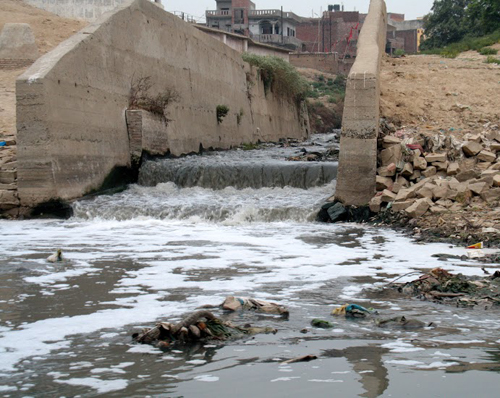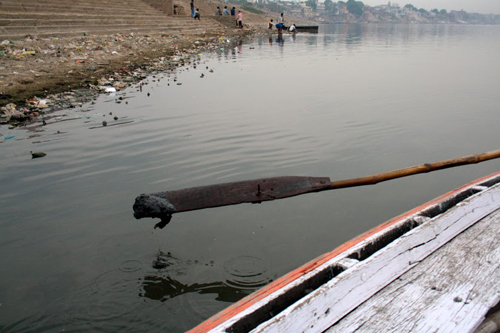He stopped rowing. The boat stopped moving. It just rocked gently. His frustration echoing across India’s ancient city Varanasi, the boatman had successfully demonstrated that the Ganga does not flow any more.
Mallu remembers despairingly the Ganga of his boyhood, pristine and dynamic. He once had to use all his strength to row upstream to carry pilgrims and tourists across Varanasi’s famed ghats but the mighty river now seems like a pond to him.
“If the government wants Ganga to be pure again, it needs its water, not schemes,” he says with conviction.
The disappointment is evident. Varanasi, the ancient town of ghats and temples in India’s Uttar Pradesh state, hit the national spotlight last year when it elected Prime Minister Narendra Modi to the lower house of parliament.
On his first visit to the city after taking power, Modi had promised to clean up the Ganga. That is yet to see fruition with the slow moving river and the mounds of garbage testament to the fact that the government’s multimillion rupee Namami Gange project, or Ganga Conservation Mission, is yet to really take off.
“All that the prime minister needs to do is sit in my boat, ride across the length of Ganga, stop each and every drain from falling into the river and more importantly stop each and every dam and barrage from withdrawing water from it,” Mallu the boatman said.
On the one hand, the water in the river, revered by Hindus as sacred, has reduced and, on the other, pollutants have increased giving it a dark brown colour and a stench. The earliest recorded coliform bacteria count – indicator of sanitary quality – in every 100 ml of water measured downstream of Varanasi was 14,300 in January 1988. This increased to 140,000 in January 2008 and to a whopping 2.4 million in January 2014.
Another indicator of water quality is biochemical oxygen demand (BOD), which should be less than 2 mg per litre of water as a drinking water source without disinfection. When the Ganga enters Varanasi, BOD is 2.8 mg/l and when it leaves, it is 4.9 mg/l – as recorded this April – indicating that large amounts of untreated sewage is discharged from the city. BOD is the amount of dissolved oxygen needed by biological organisms to break down organic material. It is considered a measure to test the effectiveness of wastewater treatment plants or the amount of organic pollution like sewage in a body of water.
Expert view
But environment scientists consider increased discharge of untreated sewage into the river an inconsequential factor as compared to reduced water flow.
“Pollution in Ganga was last century’s problem. In the last decade, the problem is that the water in the river is continuously decreasing, in turn increasing the concentration of pollutants in Ganga. If I mix 10 teaspoons of sugar each in a cup of water and in a big bottle of water, which one will be sweeter?” asked B.D. Tripathi, chairperson, Ganga Research Programme, funded by the National Ganga River Basin Authority, Central Pollution Control Board (CPCB) and the Banaras Hindu University (BHU).
Explaining the causes behind a stinking Ganga, Tripathi told thethirdpole.net that there are 5-10% more pollutants in the river since 1986, when the Ganga Action Plan (GAP) came into being. This is due to the increased flow of sewage and pollutants and reduced water.
In a parallel metaphor, U. K. Choudhary, former professor of civil engineering at Institute of Technology, BHU – the man who founded the Ganga Research Centre – refers to barrages and dams as a cancer. Higher water velocity, he stresses, would result in better water quality. Speaking to thethirdpole.net, he asked, “What can a doctor do when five out of six litres blood is removed from the human body? Even if Modiji spends 20 lakh crore (rupees), the Ganga cannot be cleaned after the water is extracted.”
In a letter to the Prime Minister, Choudhary has recommended that no more than 30% of the water should be withdrawn at the barrages, as troubles begin as soon as water levels fall. “At present more than 95% water is withdrawn through these barrages, which results in instantaneous fall in river stage, drastic reduction in flow velocity, and fall in oxygen content, rise in biochemical oxygen demand load downstream and fall in level of ground water table in the basin and lack of water quantity in the root zone, resulting in fall in crop yield, and increase in salinity in the basin soil,” he noted in the letter.
New promises
Last year, when Modi chose to contest elections from Varanasi, he had said, “Mujhe Ma Ganga ne bulaya hai (Mother Ganga has summoned me).” He made several promises to clean Ganga during the election campaign. As soon as he was elected, the new government allocated Rs.2,037 crore ($338 million) on the Namami Gange project and also opened a Clean Ganga Fund for voluntary contributions. A large part of these would be spent on building sewage treatment plants (STPs) on the banks of Ganga.
The government’s subsequent announcement of an inland waterway project called Jal Marg Vikas, Waterway Development, allowing vessels to navigate a 1,620 kilometre stretch of the Ganga, has elicited criticism from scientists and religious leaders alike.
According to Swami Avimukteshwaranand Saraswati, the head of the Vidya Math sect at Varanasi’s Kedar Ghat, the new government had built hopes of pristine Ganga but smashed them within a week of taking over when it announced that the river would be used for the transportation of goods and people. This would need barrages to maintain the water level and adversely affect its water quality and flow. “Blocking a river is the worst form of exploitation. The practice is already turning Ganga into a pond, not a river, let alone a clean river,” he told thethirdpole.net.
The seer is also critical of the government’s focus on building sewage treatment plants as previous governments followed the same strategy of sewage treatment and failed to clean the river. “They are going to spend money on sewer lines, which is not for the Ganga but for urban planning. Why should any sewage be allowed to go into the river in the first place?” he asked.
Sewage treatment
Since 1986, sewerage treatment plants (STPs) have been set up in Varanasi with a total capacity of 102 mld (million litres per day). Since the early 1990s, however, the city’s sewage generation has increased to 300 mld, with only a third of the city connected to treatment plants. GAP-II, which kicked in in 1993, sanctioned another STP and a sewer line. The STP was never built as land was unavailable and the lines remain unconnected to any of the STPs. Two parallel projects to set up STPs funded by the Japan International Cooperation Agency (JICA) and Jawaharlal Nehru National Urban Renewal Mission (JNNURM) have also been delayed.

All the STP projects in Varanasi are being managed by the Ganga Pollution Prevention Unit (GPPU), Project manager S.K. Barman, however, considers the name of the unit a misnomer. “It is a misconception that the Ganga Pollution Prevention Unit has anything to do with cleaning the Ganga. It does what water departments do in every city or town, which is provide sanitation and sewage treatment.”
When union Urban Development Secretary Sudhir Krishna visited the city in June 2014, he also found that since the sewerage system was not connected to the STPs at many places, it was not cleaning the river. Similarly, when the Central Pollution Control Board (CPCB) inspected 51 existing STPs along the length of the Ganga in 2013, the team found that not even 60% of the capacity was being used and a third of them were not functioning.
According to Tripathi, STPs are not a solution for water pollution in Varanasi as certain small industries release effluents containing heavy metals into the sewage lines, which STPs cannot remove. A BHU study published in 2010 found heavy metals beyond permissible limits in waste water and in soil and vegetables in places where the treated waste water was used for irrigation. “Continuous application of waste water for more than 20 years has led to accumulation of heavy metals in the soil. Consequently, concentrations of cadmium, lead and nickel have crossed the safe limits for human consumption in all the vegetables,” the study stated.
So both municipal and industrial waste flow into the river in Varanasi, largely unchecked. As the garbage collection system is unorganised or non-existent, large parts of the city spew waste into open drains that flow into the Ganga.
Harish Kumar Singh, 61, who was born and brought up in Varanasi and has been a guide to the city for over a decade, points to the Assi river naala or drain. The city was named Varanasi because it was located between Varuna and Assi rivers, both flowing into the Ganga. He once watched schools of dolphins at this spot as a boy. Now his eyes well up as he calls Assi a naala rather than a river.
“They (the politicians) make promises and cry for the sorry state of Ganga but to return Mother Ganga to its pristine glory does not need schemes or money, it needs genuine commitment,” says Singh.
Tomorrow: It’s not just the water, the air in Varanasi is toxic too
